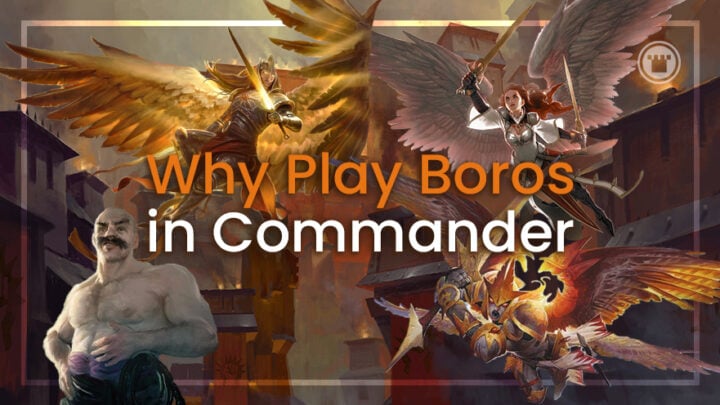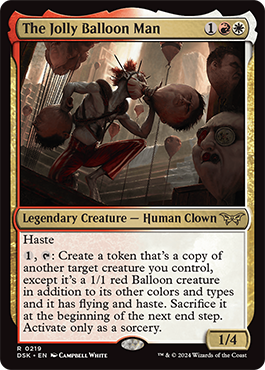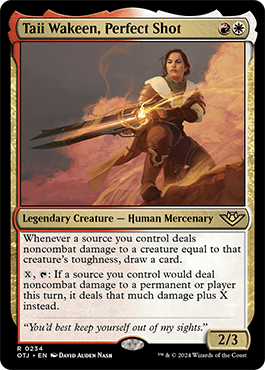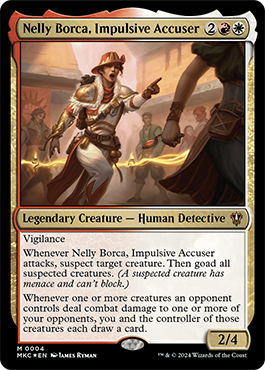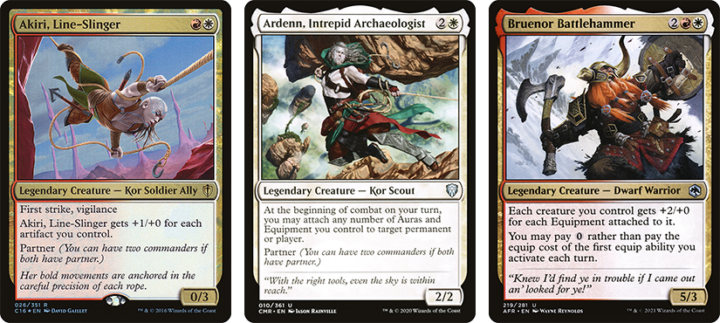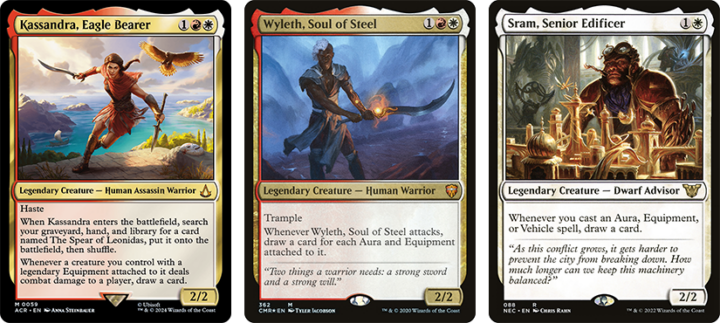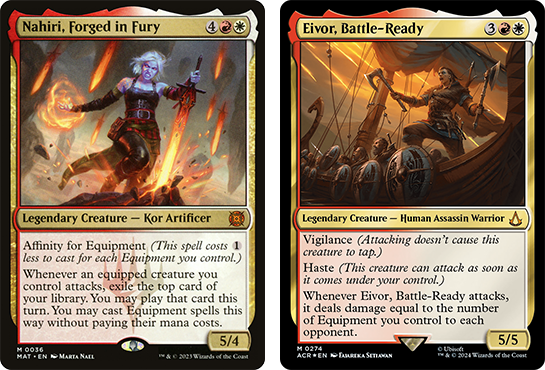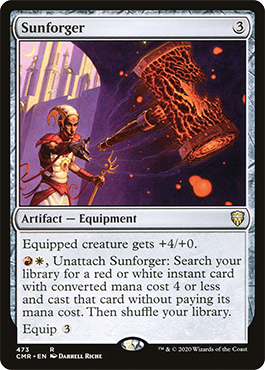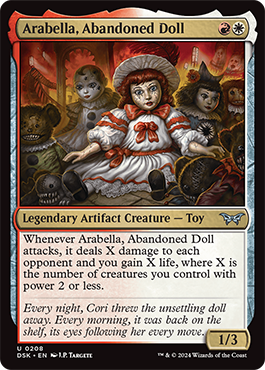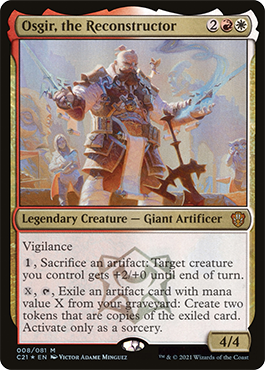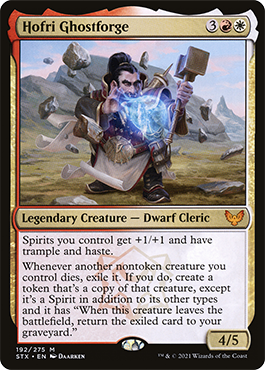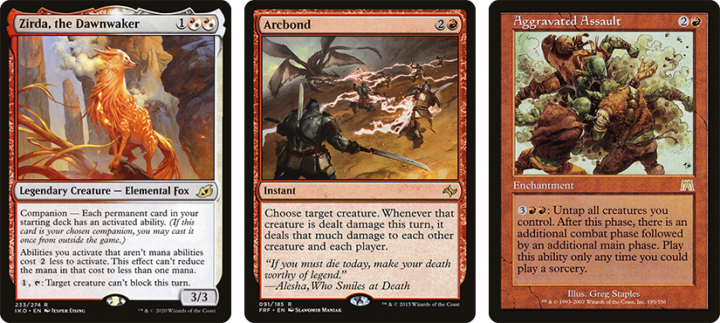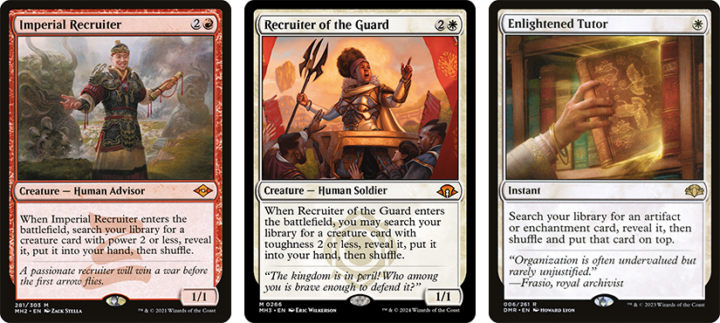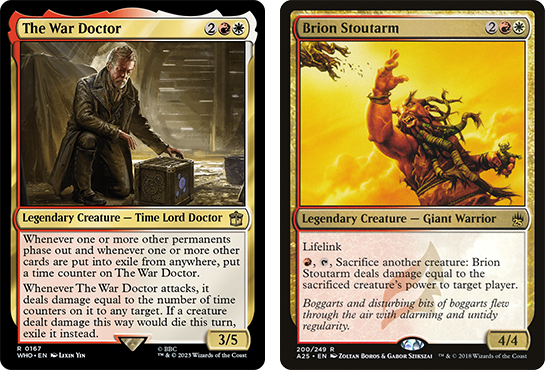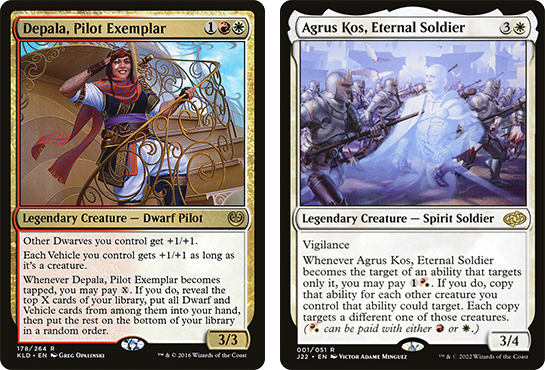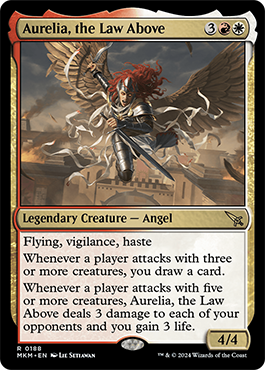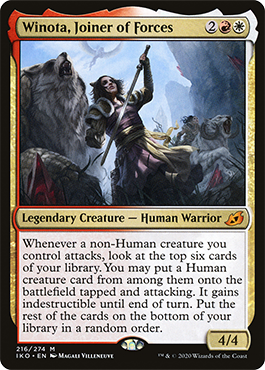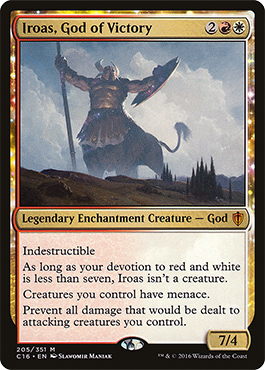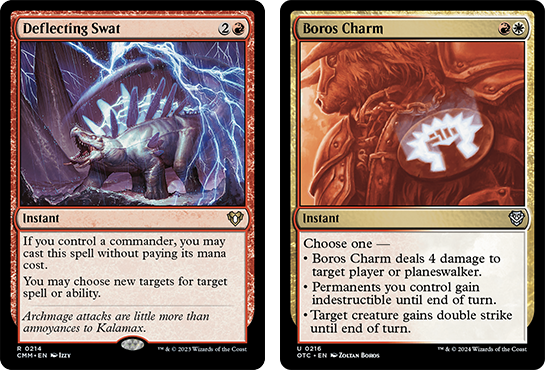Boros has a reputation for being the color pair of equipment and of attacking. Is it really so two-dimensional in Commander? Is there more to it? Why play Boros in Commander?
Boros is probably the color pair I play the most in Commander. It might be the color pair I have my highest win rates with (with some decks, at least), and it’s also, incidentally, a color pair that has historically been less popular, less powerful, and very narrow.
Today I want to challenge those notions, and bring you up to speed with why you should consider building a Boros deck.
THE FLAVOR OF BOROS
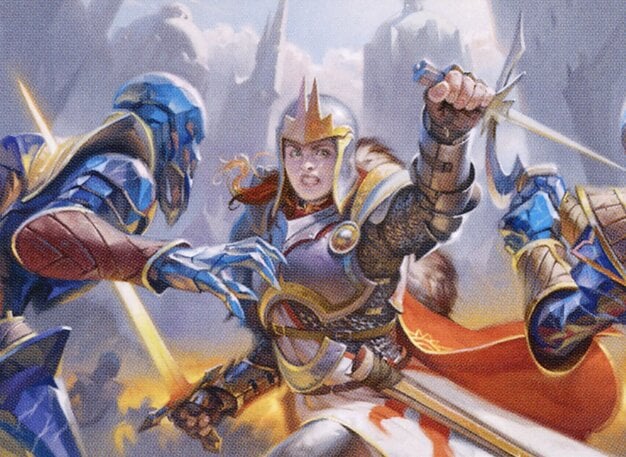
We can’t talk about why to play Boros without covering one of the main draws for many players: the flavor. Boros is the color pair of heroes. It features some of the most iconic legends in the game, and for many, that’s a huge draw. It also features plucky up-and-comers, have-a-go-heroes, and those embarking on their own “bildungsroman”.

RW decks have Soldiers, they have Warriors, they have martial artists, swordsmen, and Generals. There are Angels, Dragons, Gods and Monsters.
These decks have real “Paladin” energy, and even in their removal spells and other effects, the acts depicted are those of heroic feats and sacrifice. If any of that appeals to you, you’re probably drawn to building a Boros deck.
WHY PLAY BOROS IN COMMANDER
When figuring out why to play Boros, it’s first good to look at what each of the colors individually bring to the table:
White has historically been a support color in Commander. It can provide removal, protection, recursion and aggression to colors that lack them. It has always been a bridesmaid-and-never-the-bride color, with mono-white being considered one of the weakest mono-color decks. This is partially because white is a rule-setting color, and the strong rule-setting cards tend to be shied away from in more social games – along with white’s most destructive sorceries.
White can make other colors like blue, green and black a lot stronger. It does this for red, too, though in a different way. Primarily, when you add white to red, you get a focus on combat prowess, go-wide tactics, and equipment.
Red is a color about pure aggression. It leverages going fast and hard, and utilizes burn spells and ways to pressure opponents. It too has some interaction in the form of redirects, but above all, it wants to see life totals melting as fast as possible.
I wrote recently that Red is the new blue in Commander, and it’s because access to Haste and access to tempo-shifting redirects and other tricky effects gives red a lot of space to play as a support color.
If you look at the strengths of each individual color, and their overall flavor in the color pie, you see that white brings order and resilience to the table; red brings chaos and destruction. White can bring about destruction of its own, and red can be focused on getting results just like white. What you see is a very Yin/Yang combination, and one that feels well balanced. Discipline and results, but also the ability to pivot and follow the flow of a game.
You might even say that together, red and white present a color pair less about straight aggro, like Gruul or Rakdos, and less about Control, like Azorious or Orzhov, but, when mastered, one of flow, capable of seizing and setting the tempo.
Taking the best aggressive elements from each and the best supporting elements from each gives a color pair that can handle many situations. But, is it a color pair that does so in a narrow way? Is it a color pair with just one trick?
IS BOROS JUST EQUIPMENT DECKS?
It’s a bit of a meme at this point that Boros is known primarily for being the color of equipment decks. The thing is, it’s not just a color pair about equipment. I’d argue, in fact, that the Boros designs in recent years have been some of the freshest and most interesting ones of any color pair.
Before we dig into the main Boros archetypes, let’s just appreciate for a moment some of the more refreshing designs of recent times.
The Jolly Balloon Man lets you play Boros as a more midrange strategy focusing on Enters-the-Battlefield effects, by introducing a Kiki-Jiki type Commander that can make token copies of your creatures. When combined with white’s token doublers and red’s temporary token productions, this is a very fresh approach to tokens.
While red decks and indeed Boros decks can do burn, Taii Wakeen offers card draw in the Command Zone for only two mana, access to Boros colors, and a delightfully interesting set of hoops to jump through that can make fringe cards playable.
Auras are usually mono-white or Selesyna, but Three Dog is a Boros Auras Commander that is actually quite strong. It is very efficient – just two mana to copy an aura team wide – and there are multiple Auras that replace themselves, letting you refill your hand (a la Angelic Gift).
Boros Group-hug is also a thing now thanks to Nelly Borca. Nelly encourages attacks to go elsewhere, buying you time to sculpt an advantage. You can use Boros’ excellent control suite to pave your way to victory.
All of these new Commanders are fresh, interesting, and not at all to do with Equipment or classic Aggro strategies. So no – Boros isn’t as linear as it is collectively regarded.
THE STRONGEST BOROS ARCHETYPES
BOROS EQUIPMENT
The tried and tested Boros archetype remains equipment. Classic equipment Commanders like the Partner Commanders were the most “on theme”, but even classics like Aurelia still see a lot of casual play.
The strengths of playing RW equipment over other colors, or just mono-white, is in access to free equip costs, tutors, and equipment. Being in RW means you can play Stoneforge Mystic and Fighter Class; Forge Anew and Bruenor; Caduceus, Staff of Hermes and The Reaver Cleaver.
Thanks to the emphasis on card draw we’ve gotten since 2020, there are also plenty of Boros cards that help us with card advantage. Not only are you not limited to red’s impulse draw, Sram, and/or Puresteel Paladin; you can run Kassandra, Wyleth, and Nahiri, and playing decks with them in the Command Zone offers a good steady supply of cards to keep the pressure on with your strategy.
Boros even has access to cards that don’t have to go down the Voltron route to victory. Nahiri, in fact, encourages an entirely different build, focusing on Living Weapons and their analogues to help get the most impulse draw and the cheapest Commander. Eivor, Battle-Ready can give you ways to turn that equipment into damage without it being equipped.
Of course, Sunforger is a huge pull for RW equipment. This card gets better every year, with every free-equip effect, and every new spell that can be cast. The Outlaws of Thunder Junction Spree spells Great Train Heist and Final Showdown can be cast off this, you know. That’s pretty damn cool.
BOROS TOKENS
RW and mono-white Token Control is a powerful Standard deck right now, and part of the reason is that Boros has gotten really good at supporting tokens these days. While you have access to great ways to draw cards like Caretaker’s Talent and Welcoming Vampire, you also have excellent Commanders that can lead a deck.
What’s fun about Boros is that the different token strategies actually feel different. Anim Pakal is concerned with making lots and lots of cheap expendable bodies, and so favors Impact Tremors and Shared Animosity, and ways to draw cards like Skullclamp. General Ferrous Rokiric, meanwhile, asks you to play mostly RW multicolor spells, and concentrate on ways to remove blockers or buff your army of 4/4s. Rokiric is less likely to be removed, and can likely amass a lethal amount of damage quicker.
Then you have a Commander like Neyali. She wants you to benefit from double strike, so on-damage effects, +X/+0 buffs, and curving out with tokens from your deck, rather than the CZ, is the goal. She favors Living Weapons/For Mirrodin! cards, and has plenty of draw in the CZ.
Boros tokens, like other strategies in RW, is one that excels when it embraces the strengths of the colors. Just look at the new Arabella, an unassuming uncommon from Duskmourn. It leans into the token/go-wide approach, sure, but Arabella herself can do most of the damage. You can load her up with protective equipment (a RW strength), get a lot of tokens into play (another RW strategy) and then either take extra combats, or use damage amplification effects – or both! – to win even quicker.
It’s designs like this that can embrace all the strengths of the color pair that really shine.
GRAVEYARD
I actually think some of the stronger RW decks are those that play in the graveyard. They might feel a little unconventional, but as you’ll notice as we speak about more decks, there’s a lot more depth to Boros than they’d have you believe.
And that’s partly thanks to the Lorehold reimagining of the color pair. Osgir is a great casual deck that can be tuned up to run combos and other quick ways to win. It takes advantage of metalcraft and RW’s synergies with artifacts and provides added value in the CZ. It even has a somewhat clunky win condition, paying and sacrificing to provide a buff. You can even add the token doublers in white to this for extra value.
Hofri is my pet deck, and I often call it my “Sultai” deck because of how it plays and the win conditions therein. It likes to get cards into the yard with the limited self-mill available in the colors and by using wheel effects like Wheel of Fortune (and the rest). The win conditions are cards like Cavalier of Flame and Hallowed Spiritkeeper, and, by leveraging burn effects, sacrifice effects (to get token copies), and ways to double up like Roaming Throne, these win conditions are powerful and fun, while being off the beaten path.
The deck finds it a little harder to present a deterministic combo than when it had access to Dockside Extortionist, but that leads me onto…
BOROS AS A COMBO COLOR
Boros Combo. Boros is actually a really good color pair to play combos in. It has all sorts of combos, from loops involving the various Altars to mill or have infinite EtBs that ping opponents, to infinite mana generation via Zirda and Basalt Monolith for a burn spell, to using Arcbond and damage redirects to creatures like Brash Taunter, to the simple and satisfying infinite combats gained through Aggravated Assault with Feast and Famine or Reaver Cleaver.
The combos get weirder, though, with Aurelia the Warleader having access to 18 different ways to win alone, and cards like Gerrard who are able to loop themselves with Loyal Retainers, Nim Deathmantle, or other effects.
One thing that makes Boros such a good combo color is access to tutors to find pieces of combos. If you need equipment, you are spoiled for choice. If you need small creatures, you have the recruiters, and you have many ancillary tutors also, and plenty of redundancy of effect.
You can run Fiend Hunter with Karmic Guide and Sun Titan, for example, and any sacrifice outlet will work.
Boros can function as a combo color because of the complementary controlling elements RW has access to. It can wipe the board or remove and exile opposing problems with ease, and it has access to lifegain to help ride out the game until it can combo off. It can protect key pieces with a myriad of protection spells and effects, and ways to shut down spellcasting within your turn – some of which, like Grand Abolisher or Conqueror’s Flail, are even tutorable.
What’s more, many decks with combos are perfectly capable of winning through combat, thanks to Boros creatures and effects helping even the smallest armies achieve great things.
OTHER GREAT BOROS BUILDS
While Boros may have its “best” decks, there are still countless ways to play the color pair.
Burn decks (which can cross over with token decks) are a go-to for Boros, and they come in many flavors. The War Doctor can be a finely tuned combo deck that can nuke a table if you know what you’re doing, and otherwise lets you play with exile as your main theme. Brion Stoutarm, on the other hand, throws around big creatures to deal damage. He can be used as a deck full of effects that steal opposing creatures for that extra mechanical fun.
Boros can even do Spellslinger, with Feather being arguably one of the strongest and most consistent Boros Commanders available. She is leagues above many of the other Spells-based Commanders, but thanks to strong effects like Reconstruct History, other options abound, like Velomachus Lorehold, who operates as a quite controlling build.
If you don’t want to play with the more tried-and-tested Boros strategies, there are still dozens of unique builds out there. The more “midrange” boros decks are sometimes the most mechanically unique, and therefore the most fun and interesting options.
You’ve got everything from Vehicles with Depala or Astor, to weird decks like Agrus Kos, Eternal Soldier. Agrus can utilize unique interactions like Basilica Skullbomb to jump your whole team and refill your hand, and win with crazy stacks of damage from Thundering Raiju.
Even a deck like Odric, Blood–Cursed offers unique building approaches for RW. Sure, it’s asking you to play a bunch of keywords, but it’s also asking you to think about how to leverage making a bunch of artifact tokens.
The strongest Boros decks are often the most-focused on these more niche or different approaches to gameplay, and that’s just pretty cool. There’s a lot more variety in how to aggressively murder the table than there is with most of the Simic landfall Commanders, for example.
You also have some great “reach” on Boros cards – and I mean gameplay wise, not mechanic wise. Boros has some great midrange tools to help it close games. You can add Eivor to an Equipment deck, or Eomer, King of Rohan to a Humans build. Eomer can nuke a player in the face while providing you with a huge threat to close a game.
Similarly, the modes on Aurelia, the Law Above add up to keep the pressure on and the cards flowing. You can slot her into your curve if you care about going wide, whether with tokens or keyword soup builds. Look at the composition of your deck and figure out what gives it that extra punching power.
You could even add Winota, Joiner of Forces as a treat, if your build allows for it. She’s overbearing in the CZ outside of cEDH, but a perfectly reasonable value engine in the 99.
BOROS VALUE FOR EVERY DECK
Whatever strategy and Commander you go with in Boros, there are certain strengths of the color pair – certain effects that you can take – that you absolutely must consider, no matter what your build actually is.
Leveraging haste is one. You’ll want to use it as much as possible, whether in your spells or your manabase, in order to get in there and seize the tempo.
The other is taking a bowl of “Keyword Soup”. While Commanders like Akroma (with Rograkh, usually) or Odric remain strong options, they are also very valuable in the 99 of plenty of builds. Boros decks often have plenty of good keywords, but they are often on singular creatures. By sharing them around or adding buffs, you can build bigger tokens or bigger midrange beats.
A card like Iroas is just good in many builds provided you want to be attacking, for example.
You’ll want to utilize RW’s unparalleled access to protective interaction to keep your board in play. Whether it’s through cards like Boromir or Selfless Spirit as on-board ways to save your stuff, or using Deflecting Swat, Bolt Bend, Teferi’s Protection or Boros Charm, there are plenty to choose from. And there will be options that synergize well with whatever build you’re on.
Extra combats are basically like extra turn spells for RW decks, and in many ways, they can give you the room you need to close a game. Whether you run Aurelia, Waves of Aggression (great with Land Tax!), Great Train Heist, or Response // Resurgence, adding one or two of these to your build can complement your strategy.
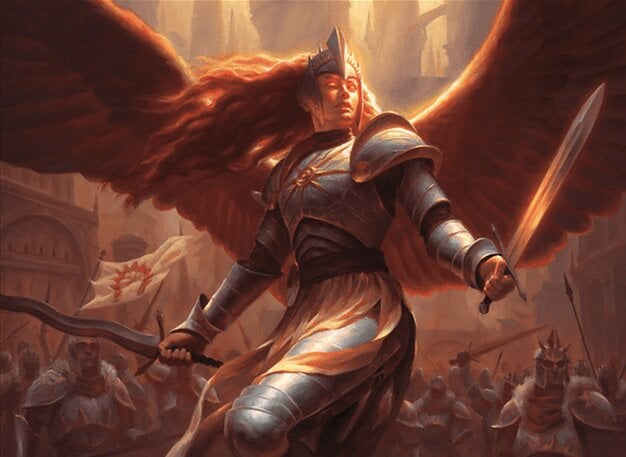
END STEP
Boros is a great color pair in Commander, for many reasons. It has access to aggressive approaches, Voltron, and Combo, and it can also play around with Artifacts, in the Graveyard, or with some really weird and niche builds.
It has access to great card draw options these days, and some of the best interaction outside of blue counterspells. It can play controlling as well as it can aggro, and is uniquely positioned to pivot with access to haste and combos.
Thanks to a big push from the designers, it’s also home to many unique, fun, and interesting builds. Hopefully this article has showcased exactly why I love to play Boros.
For further reading, try:
- Four Boros Decks to Light Your Fire
- The Best Boros Sunforger Toolbox
- The Boros Advantage & Ramp Engine

Kristen is Card Kingdom’s Head Writer and a member of the Commander Format Panel. Formerly a competitive Pokémon TCG grinder, she has been playing Magic since Shadows Over Innistrad, which in her opinion, was a great set to start with. When she’s not taking names with Equipment and Aggro strategies in Commander, she loves to play any form of Limited.

